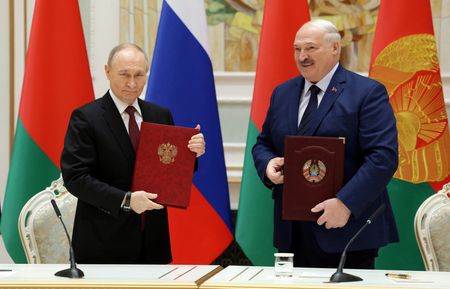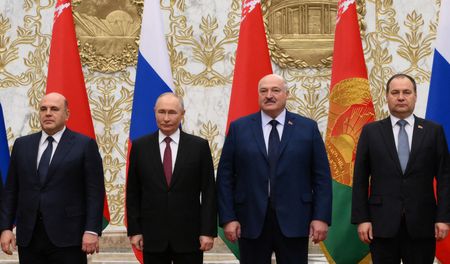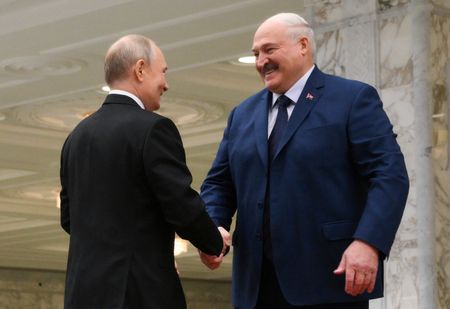By Lucy Papachristou and Dmitry Antonov
MOSCOW (Reuters) -President Vladimir Putin said on Friday that Russia could deploy its new Oreshnik intermediate-range hypersonic missile on the territory of its ally Belarus in the second half of next year.
Putin was responding to a request from Belarusian President Alexander Lukashenko at a summit in Minsk, where the two leaders signed a mutual defence pact.
“… since we have today signed an agreement on security guarantees using all available forces and means, I consider the deployment of such systems as the Oreshnik on the territory of the Republic of Belarus to be feasible,” Putin said.
“I think this will become possible in the second half of next year, as serial production of these systems in Russia increases and as these missile systems enter service with the Russian strategic forces,” he added in televised comments.
Russia first fired the Oreshnik at the Ukrainian city of Dnipro on Nov. 21, in what Putin cast as a response to Ukraine’s first use of U.S. ATACMs ballistic missiles and British Storm Shadows to strike Russian territory with Western permission.
Putin has said Russia may use the Oreshnik again, including to hit “decision-making centres” in Kyiv, if Ukraine keeps attacking Russia with long-range Western weapons.
Russian Foreign Minister Sergei Lavrov told U.S. journalist Tucker Carlson in an interview released late on Thursday that Moscow’s firing of the Oreshnik was a signal that the West must take it seriously.
ORESHNIK
Putin has boasted that the Oreshnik (hazel tree) is impossible to intercept and that it has destructive power comparable to that of a nuclear weapon, even when fitted with a conventional warhead.
Some Western experts have cast doubt on Putin’s claims about the missile, which they say is based on a system that Russia had at one point tested as an intercontinental weapon before putting its development on ice.
The experts said the novel feature of the Oreshnik was that it carried multiple warheads capable of simultaneously striking different targets – something usually associated with longer-range intercontinental ballistic missiles.
On Friday, Putin told Lukashenko that Belarus – which shares borders with NATO members Poland, Latvia and Lithuania – would determine the targets for Oreshniks based on its territory.
Putin said the new mutual defence treaty “will make it possible to reliably protect the security of Russia and Belarus”, the TASS state news agency reported.
Last month Putin approved changes which lowered the threshold for a nuclear strike in response to a broader range of conventional attacks and extended Moscow’s nuclear umbrella to cover Belarus.
Nuclear weapons were withdrawn from Belarus after the fall of the Soviet Union in 1991, but Putin announced last year that Russia was placing tactical nuclear missiles there as a deterrent to the West.
Lukashenko said in October that any use of Russian nuclear weapons deployed in Belarus would require his personal consent.
(Reporting by Dmitry Antonov in Moscow, Lucy Papachrisou and Maxim Rodionov in London and Felix Light in Tbilisi, Editing by Mark Trevelyan and Gareth Jones)



